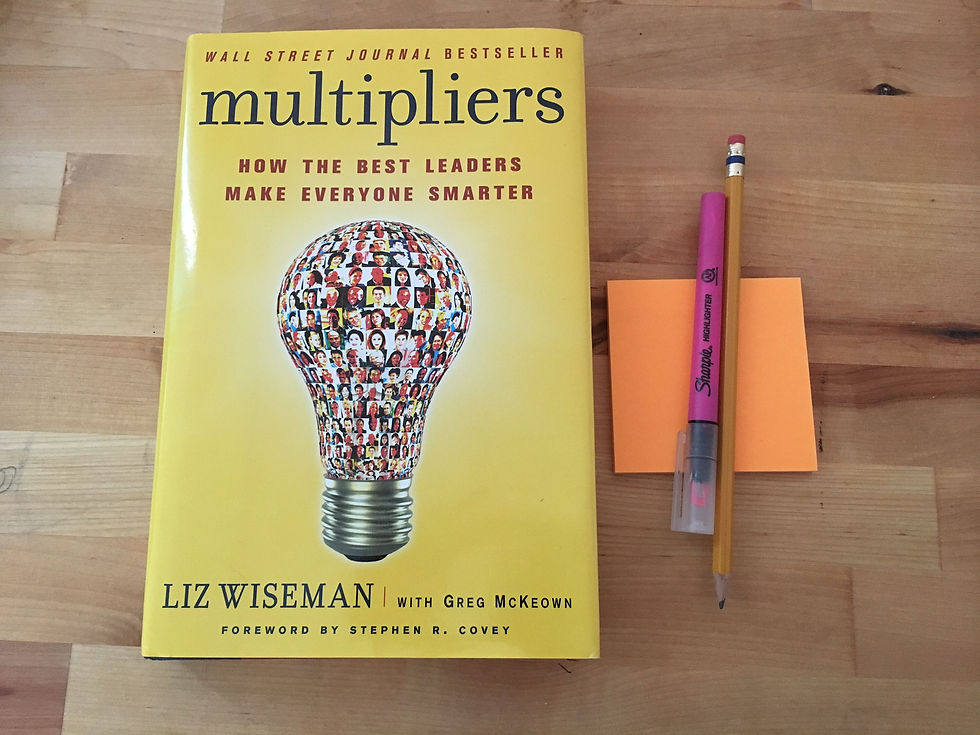Book Review
- jess
- Jul 31, 2017
- 3 min read

I recently finished Multipliers: How the Best Leaders Make Everyone Smarter by Liz Wiseman. There is much to learn from her theory about what good managers do (or don't do) to bring out the best in themselves and their team. I'll summarize the bulk of it below, as well as describe the parts of the book that were more difficult to get through.
Wiseman, a 17 year Vice President at Oracle Corporation, set out to interview 150 executive leaders across a broad spectrum of industries. Some patterns began to emerge throughout the course of her research. Great leaders had the effect of increasing what she calls "the intelligence" of their direct reports. Ineffective leaders diminished "the intelligence" of their team members.
The opening of the book sets the context for management styles that can be described as either "multiplier" or "diminisher". The idea of intelligence was initially a stumbling block for me because she did not go into detail about the depth and breadth of what intelligence might mean...until the second chapter. There she expands upon the idea that nurturing intelligence is really about creating an environment that allows people's gifts or strengths--whatever those may be--shine. When she refers to "intelligence" she is referring to people's talents, not necessarily their IQ's.
There were five behaviors she identified that were consistent among all "multiplier" managers. A multiplier is a/n:
1) Talent Magnet: actively recruits diverse and talented staff,
2) Liberator: requires people's best thinking,
3) Challenger: brings a variety of challenges to the team,
4) Debate Maker: nurtures debate before solutions were solidified,
5) Investor: creates a culture of high standards and accountability.
In each chapter, Wiseman describes what each of the five behaviors demonstrated by multiplier managers look and feel like in the workplace. Describing "The Talent Magnet", she writes, "In their quest to assemble the finest talent, Talent Magnets are blind to organizational boundaries. They see the multiple forms of intelligence that exist everywhere. Talent Magnets live in a world without walls and without hierarchical or lateral restrictions...instead, they see talent networks...The idea is simple. Multipliers understand that people love to contribute their genius. If they put effort to figure out someone's genius, they have opened a pathway for that person to contribute."
Conversely, there are "diminisher" managers, whom she describes as people who believe intelligence is a rare trait. Dimishers believe their intelligence, or natural talent, is paramount to the success of the team. They center their own perspectives, micromanage teams, and believe intelligence, or talent, is scarce and finite. Not only do people NOT ENJOY working for diminishers, the outcomes of teams led by diminishers are not as positive as outcomes of teams led by multipliers.
Over the course of 235 pages, Wiseman brings the multiplier and diminisher to life. She is careful to point out that no one is either always a multiplier, or always a diminisher. Her framework for understanding management styles is not a dichotomy, but is instead a spectrum. Hopefully, we are managers whose behaviors are more on the multiplier end of the spectrum, and less on the diminisher end of the spectrum. She also shares concrete tools managers can use to become more of a multiplier manager.
Overall, if you can internalize the idea of intelligence NOT being strictly IQ, then this book offers a road map of how to become the manager we all hope to be: "Multipliers have a rich view of the intelligence of the people around them...Multipliers see intelligence as continually developing...They assume people are smart and will figure it out. They see their organizations as full of talented people who are capable of contributing at higher levels".
Contact jess@thomkeconsulting.com if you would like support in exploring and developing your management style and skills.



Comments